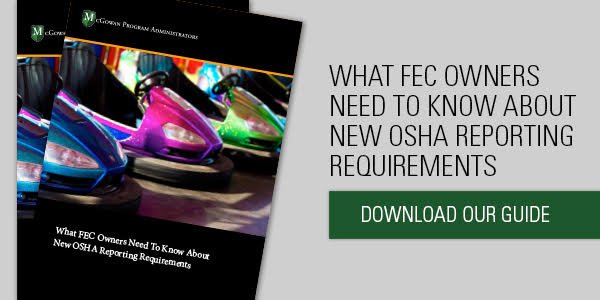If an employee is injured at your family entertainment center (FEC), it is crucial to do more than the basics of calling 911 and ensuring they receive immediate medical attention. You must also maintain detailed records of every incident to stay OSHA-compliant. Severe injuries and fatalities must be reported to state or federal authorities within a strict time frame; failing to do so could result in significant penalties.
Additionally, you must keep records of workplace safety incidents for five years and may need to submit an annual summary. However, FECs with ten or fewer employees are partially exempt.
This blog post will clarify your responsibilities regarding reporting and recordkeeping.
What businesses must report injuries to OSHA?
FECs are often small businesses in the literal sense. Locally owned and operated, these mom-and-pop organizations usually serve a community with only a handful of employees.
Because of their small size, FEC owners might not realize that they are also subject to the basic reporting and recordkeeping rules regarding workplace injuries and illness overseen federally by the Occupational Safety and Health Administration (OSHA). OSHA inspectors hand out steep fines to businesses failing to report serious injuries and deaths within the allotted time frame, up to $7,000 per incident.
OSHA requires all employers in the U.S. to file a Serious Injury Report (SIR) within eight hours of a death and twenty-four hours of a serious injury, defined by OSHA as:
- in-patient hospitalization,
- amputation,
- or lost eye.
After OSHA receives a report, it decides if further investigation is warranted. These inspections can unearth safety violations that could lead to substantial fines or other regulatory consequences like closures or loss of licensure.
Note that “in-patient hospitalization” does not necessarily mean an overnight stay. Generally, in-patient means an employee was checked in by a doctor and referred for treatment in the hospital. Being kept for observation overnight does not count unless it leads to further treatment.
To report a serious injury to OSHA:
- contact your local OSHA branch,
- file a report online,
- or call them at 800-321-6742 to file a report after business hours.

Are your FEC’s reporting practices OSHA-compliant? Download our e-book to find out.
What organizations are exempt?
OSHA’s basic recordkeeping rules do not apply to businesses with a maximum of ten employees at any time. This count includes all workers—full-time, part-time, temporary, and seasonal. The exemption is company-wide, so multiple locations contribute to the total employee count.
However, all employers must report serious injuries (as previously defined) and deaths within the specified deadlines. While some low-risk industries, such as certain retailers, are partially exempt from recordkeeping, amusement parks and FECs are not.
Documenting workplace injuries
Beyond the basic requirement to report SIRs and workplace fatalities immediately, OSHA requires organizations with more than ten employees to track life-threatening illnesses and injuries and report them annually. Even if exempt, keeping safety and injury records is advisable, as compliance requirements may change if your business expands or acquires other companies.
Documentable ailments include the following:
- Work injuries that lead to loss of consciousness, sick days taken, restricted work environments, or employee transfers to other departments or jobs
- Medical treatments beyond rudimentary first aid
- Irreversible chronic illness
- Cancer
- Heart attack leading to death or in-patient hospitalization
- Broken or fractured bones or teeth
- Perforated ear drums
Special forms and reporting criteria are needed for the following:
- Needle punctures and sharp-object injuries
- Medical amputations in the aftermath of an injury
- Hearing loss
- Tuberculosis
Be aware that in addition to OSHA regulations, 28 U.S. states, Puerto Rico, and the Virgin Islands may impose additional safety requirements. Furthermore, specific states might have rules that apply exclusively to public-sector employees. Depending on your location, you may need to submit reports to state regulators instead of OSHA. No state can have fewer safety regulations than the minimum established by OSHA.
Also read: Preventing Slips and Falls at Theme Parks
While OSHA reporting and recordkeeping can be time-consuming, the information generated offers real value to businesses. Companies aware of their accountability for safety violations and workplace incidents are motivated to maintain a safe environment for their employees and avoid OSHA inspections. Additionally, OSHA analyzes reporting data to detect trends and identify repeat offenders.
While meeting OSHA reporting and documentation requirements is crucial, having the right insurance is essential to mitigate unpreventable accidents. McGowan Program Administrators (MPA) offers the OSHA compliance guidance your FEC needs to avoid costly fines and foster a safe work environment.
The Amusement & Entertainment Insurance Program from MPA is designed to address the unique risks associated with operating amusement establishments like FECs. This program, backed by years of industry experience, offers comprehensive training and education through an online portal, 24/7 risk management support, and on-site inspections. Additionally, IAAPA members can benefit from a 10% rate credit, emphasizing that safety is an invaluable investment.
Contact our experts with any questions.


